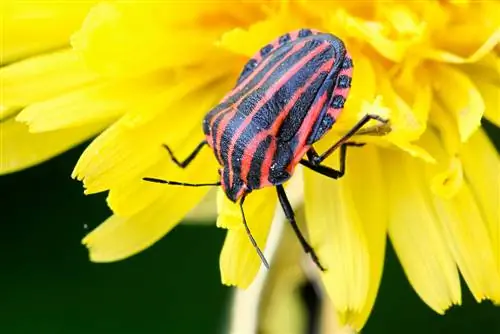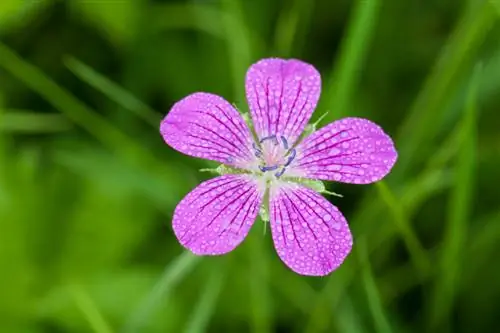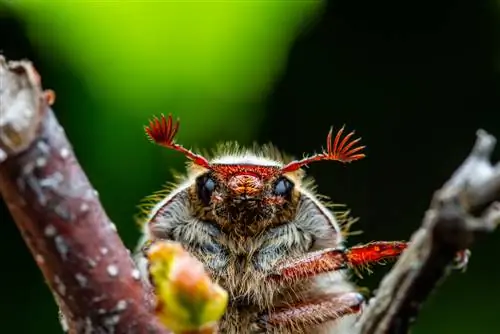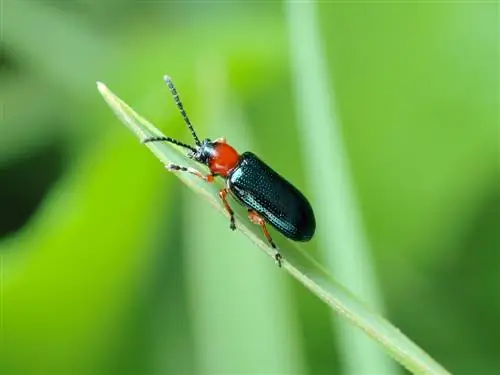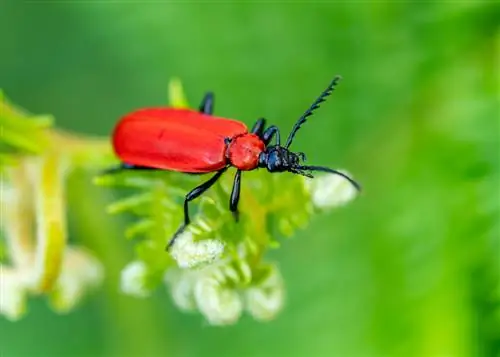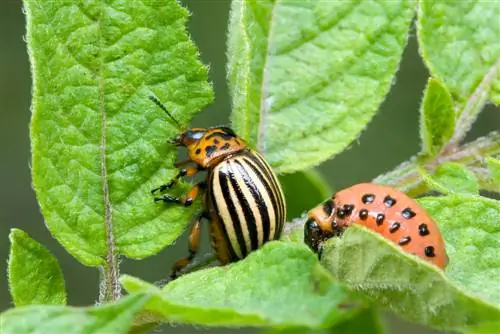- Author admin [email protected].
- Public 2023-12-16 16:46.
- Last modified 2025-06-01 06:02.
Beetles with a red and black look do not remain hidden from the attentive observer for long. A precise determination is based on knowledge of defining characteristics. Not every beetle-like insect is actually a beetle. This guide introduces you to 10 native insects that show off in Germany with a red-black color combination.
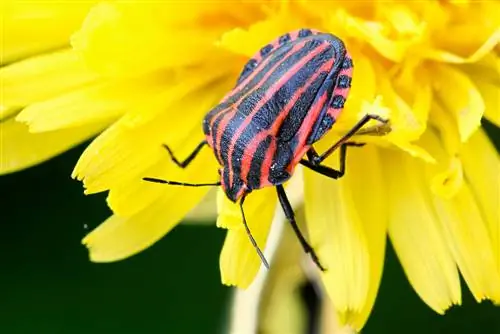
Which beetles are red-black in Germany?
Red-black beetle species in Germany include fire bugs, striped bugs, lily beetles, seven-spotted ladybirds, bee beetles, red-necked grain beetles, four-spotted jugglers, harlequin ladybirds, wart beetles and barge beetles. They vary in size, color, body shape, leg color and special features.
- Native beetles in red-black (predominantly red) are: fire bug (patterned), striped bug and bee beetle (red-black striped), lily cockerel (red-black pest) and seven-spot ladybird (dotted).
- Red-black beetles in the garden (predominantly black) are: grain chicken (red neck), four-spotted juggler (spotted), harlequin ladybird (red spotted), wart beetle and cockerel beetle (red spotted).
Identifying red-black beetles - 5 species predominantly red
Native beetles make identification easy for hobby gardeners when the red color dominates their appearance. The following table names 5 common red-black beetles that are widespread in Germany:
| Mostly red | Firebug | Stripe bug | Lily Chicken | Seven-spotted ladybug | Beetles |
|---|---|---|---|---|---|
| Size | 6-12mm | 8-12mm | 6-9mm | 5-8mm | 9-16mm |
| Color tone | bright red-orange | deep red | sealing wax-red | light to deep red | bright red |
| Body shape | flat-oval | rounded, flat | long-slim | spherical curved | elongated |
| Color legs | black | black | black | black | black |
| Special feature | black patterned | striped | long black antennae | black dots | blue-black horizontal stripes |
| Botanical name | Pyrrhocoris apterus | Graphosoma lineatum | Lilioceris lilii | Coccinella septempunctata | Trichodes apiarius |
| Middle name | Firebugs | none | Lily Beetle | Sevenpoint | Immen beetle |
| Family | Firebugs | Stunk Bugs | leaf beetles | Ladybug | Colored beetle |
The following short portraits provide in-depth explanations for a well-founded beetle identification.
Fire bug (Pyrrhocoris apterus)
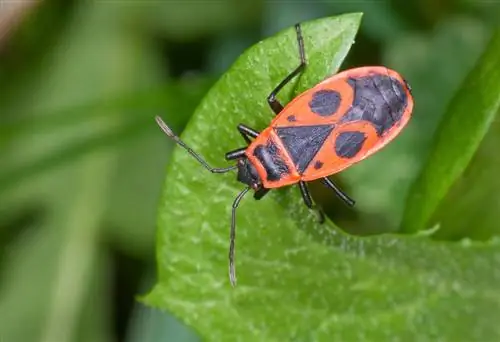
Fire bugs are harmless and cause little damage
The fire bug would actually rather be a beetle. Six black legs support the flat oval body with a distinctive red and black pattern. The trapezoidal pronotum is bright red with a rectangular black spot in the middle. Fire-red elytra, decorated with round and square spots, are striking. A leaf-shaped, red lateral edge can be seen on the abdomen, which is colored black in the middle. Underside, head and antennae are black.
- When to find: April to August/September
- Where to find: under a tree, preferably linden, on a mallow family, such as hibiscus
Stripe bugs (Graphosoma lineatum)
If a beetle has red and black stripes, it is actually a bug with a peaceful disposition. With its distinctive striped coat, the striped bug (Graphosoma lineatum) wants to scare off its enemies, who hunt the harmless plant sucker in Germany and Austria. Stripe bugs prefer to suck on ripening seeds and do not touch other parts of the plant. Anyone who can take a look at the underside of the beetle-like bug can admire black dots on a red background.
- When to find: April to October
- Where to find: in the garden, preferably on umbelliferous plants, such as men's faithful, angelica, gourd, dill or fennel
Lily chick (Lilioceris lilii)
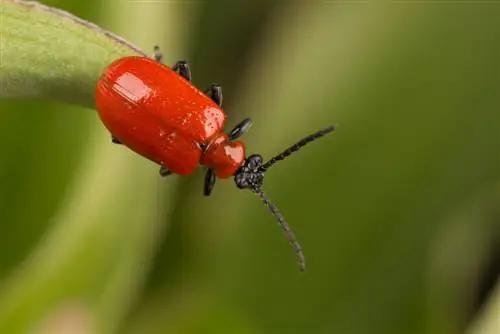
The lily chicken is a serious pest that affects more than just lilies
The pronotum and red, rounded cover wings of a lily chicken sparkle like they were freshly painted. The jet-black legs, antennae, head and underside contrast impressively. The strikingly long, black antennae are made up of eleven segments.
- When to find: end of March/beginning of April to September
- Where to find: on lily, crown imperial, checkerboard flower, lily of the valley, chives
Seven-spot ladybird (Coccinella septempunctata)
Representing the colorful diversity of native ladybird species is the German's favorite red-black beetle, the seven-spotted beetle. The flying symbol of luck can be recognized by its spherical, strongly curved body. There are three black dots on each of the bright red wing wings. The seventh point is flanked by two white triangular marks. The black neck shield is decorated with two white corners at the front. Two white dots flash on the inside of his black compound eyes.
- When to find: April to October
- Where to find: in the garden always near aphids
The following video invites you to take a journey through the life of the most popular red-black beetle in Germany, the wonderful seven-spot ladybird.

Bee beetle (Trichodes apiarius)
From the colored beetle family, the beetle has chosen a red-black appearance, spiced up with blue-green, shiny metallic applications. The bright red elytra have blue-black crossbands. Neck shield, head and legs sparkle blue or green metallic.
- When to find: May to July
- Where to find: in the garden, on the sunny edge of the forest, on sparse hedge edges, in meadows
Excursus
Which red-black beetle eats flowers?
Hobby gardeners often carry out beetle identification to identify a pest in the garden. If the search is aimed at a beetle in red and black that attacks lilies and flowers, the answer is: lily chicken. Gardeners who are close to nature don't let the pest dance around on their faces and resort to tried and tested home remedies to combat it. The best results are achieved with a strong water shower, powdering with algae lime and a spray of 15 ml curd soap, 15 ml spirit in 1 l water.
Identify red-black beetles - 5 species predominantly black
Various domestic beetles prefer a more subtle appearance and complement their predominantly black coloring with red dots, spots and other decorations. The following 5 species are commonly found in Germany:
| Mostly black | Red-necked grain chicken | Four-spotted Juggler | Harlequin Ladybug | Wart Beetle | Barge Beetle |
|---|---|---|---|---|---|
| Size | 4-5mm | 8-11mm | 4-8mm | 3-4 mm | 4, 5-6 mm |
| Color tone | metallic-black-red | matt-black, dark-red | shiny-black-red | greenblack-red | metallic-black-red |
| Body shape | roll-shaped | oval | spherical-domed | long-slim | boat-shaped |
| Color legs | red-orange | black | black | yellow-brown | black |
| Special feature | red-orange neck shield | red crescent spots | red dotted | red spotted | red horizontal spots |
| Botanical name | Oulema melanopus | Hister quadrimaculatus | Harmonia axyridis | Anthocomus equestris | Scaphidium quadrimaculatum |
| Middle name | Grass Chicken | Joker | Asian ladybird | Two-spotted wart beetle | Four-spotted Cock Beetle |
| Family | leaf beetles | Cutter Beetle | Ladybug | Eye beetle | Rapid winged bird |
Have the above characteristics put you on the right track to identify the red-black beetle? Then read on, because the following short portraits provide further details:
Red-necked grain chicken (Oulema melanopus)
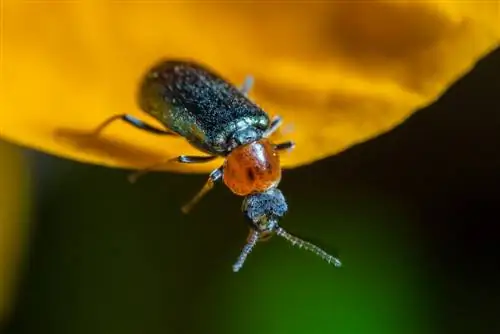
The red-necked grain chicken is a grain pest
Red pronotum and black-blue wing covers give the red-necked grain chicken its name. Appropriately, the native insect walks through life on red-orange legs. The pronotum is finely dotted, the cover wings have a coarser dot pattern.
- When to find: March to October
- Where to find: in meadows, forests, grain fields, in the garden on sweet grasses
Four-spotted juggler (Hister quadrimaculatus)
The name says it all. A four-spotted juggler is easy to identify by the pair of red spots on each of its black wing coverts. The red blemishes are shaped like a crescent moon and are connected to each other. Delicate dot stripes extend over the patterned wing coverts.
- When to find: April to August
- Where to find: in warm garden corners, often near pastures with horses, cows and sheep
Harlequin ladybird (Harmonia axyridis)

The Harlequin ladybird is originally from Asia
At the beginning of the 2000s, the Asian ladybird was imported to Germany to combat aphids. Since then, the new resident has settled in so well that it is considered a native beetle species. Its shiny black, highly arched wing covers are usually spotted with red or orange. However, the ladybug loves variety, which is what its name suffix Harlequin refers to.
- When to find: April to October
- Where to find: wherever there are aphids
Wart beetle (Anthocomus equestris)
The two-spotted wart beetle brilliantly demonstrates how to present yourself decoratively as a wart beetle. The slim, black body is decorated with red wing coverts with a black spot in the center and a black cross band on the back half. The rest of the abdomen is again red.
- When to find: April to June
- Where to find: in the garden, in the compost, in potting soil, sometimes in the house
Cock beetle (Scaphidium quadrimaculatum)

The punt beetle has a matt shiny black and red shell
If you encounter a red-black beetle with a boat-shaped body, you are looking at a boat beetle. Four red spots on the shiny black shell remove any remaining doubts about identity.
- When to find: all year round
- Where to find: on the tree, more often in the forest, less often in the garden
Tip
Haute couture in beetle style celebrates the red-black soft beetle (Cantharis pellucida), which is native and widespread in Germany. The front head and pronotum are red, the front legs and thighs are reddish-yellow, as is the first antennal segment. The elytra, back of the head, tarsi of the middle legs and the hind legs are dull black. The beetle spreads this picturesque red-black play of colors over a tiny 10 to 13 mm body length.
Frequently asked questions
Can fire bugs fly?
No, fire bugs can't fly. The vast majority of 95 percent of the population in Germany only have very shortened wings, which do not allow the insect to take to the air. The wings of around 5 percent of domestic fire bugs are normally developed. Nevertheless, the red and black natural beauties don't think about flying through the garden.
Is the red and black striped bug a pest?
No, the red-black stripe bug (Graphosoma lineatum) is not a pest. The native species of bug in striped dress feeds primarily on the juice of ripe seeds. Leaves, flowers or buds are not on the diet of the peaceful plant sucker, or only in exceptional cases.
Red-black spotted beetles flying around the house and sitting on the window pane? What kind is this?
According to your description, they could be horsetail beetles (Anthocomus equestris). The 4 mm small beetles are red with black spots on the wing coverts. The beetles probably entered the house as stowaways in potting soil. Please release the harmless insects into the wild by opening the windows for a short time.
Tip
The red-black insect looks like a hairy ant, but is a beetle. Foresters have taken the ant beetle (Thanasimus formicarius) to their hearts because it hunts voracious bark beetles. Body and pronotum are red. The black elytra are decorated with two white, elegantly wavy transverse bands. The picturesque appearance is rounded off by black legs, red shoulders and reddish tarsi.

